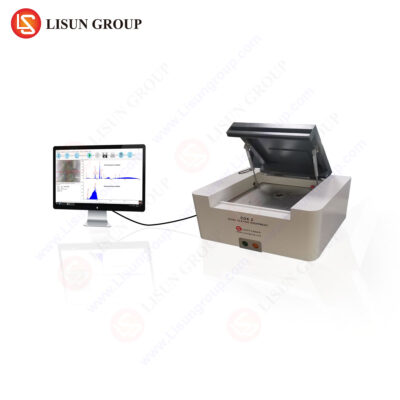
The RoHS tester is an instrument used to detect the presence of hazardous substances restricted by the EU RoHS standard, primarily detecting six harmful substances including lead (Pb), cadmium (Cd), mercury (Hg), hexavalent chromium (Cr6+), polybrominated diphenyl ethers (PBDE), and polybrominated biphenyls (PBB).
The RoHS tester typically refers to an X-ray fluorescence spectrometer, with an analysis principle similar to that of X-ray fluorescence spectrometers. X-ray fluorescence spectrometers are mainly divided into wavelength dispersive and energy dispersive types. Wavelength dispersive X-ray fluorescence spectrometers consist of excitation sources, spectrometer crystals and goniometers, detectors, and other components, while energy dispersive X-ray fluorescence spectrometers are relatively simple, requiring only excitation sources, detectors, and related electronic and control components.
Specific excitation sources are required to obtain characteristic spectral lines of the elements to be tested, commonly including X-ray tubes and isotopic excitation sources. To obtain qualitative and quantitative information from the samples, appropriate sample preparation techniques are required, along with spectral analysis and data processing of the obtained spectral line intensities. Utilizing the principle of X-ray fluorescence spectrometers, RoHS testers can accurately and rapidly analyze the content of harmful elements in samples, providing essential support for product quality control and environmental protection.
The application fields of RoHS testers are extensive, including but not limited to the following:
• RoHS and hazardous element testing for large-volume components: Suitable for testing hazardous elements in large components to ensure compliance with RoHS standards.
• On-site material testing of electronic components and parts: Used for rapid on-site testing of materials in electronic components and parts to ensure they are free of harmful elements.
• On-site spot checks of toys, stationery, children’s products, and gifts: Used for on-site spot checks of items such as toys, stationery, children’s products, and gifts to ensure their safety.
• Testing and validation of packaging materials: Can test various types of packaging materials to verify they are free of harmful elements, ensuring product safety.
• Hazardous substance testing and validation for various types of batteries: Applicable for testing various types of batteries for hazardous substances to ensure they meet safety standards.
• Testing of hazardous elements in electroplating solutions: Used for testing hazardous elements in electroplating solutions to ensure the electroplating process meets environmental requirements.
• Detection of harmful elements in materials such as fabrics and shoe materials: Can detect harmful elements in materials such as fabrics and shoe materials to ensure product quality.
• Testing of hazardous elements in jewelry and accessories: Used for testing hazardous elements in products such as jewelry and accessories to ensure they are safe and harmless.
EDX-2A_RoHS Testing Equipment
Maintenance Measures:
• The equipment should be installed in a place free of electromagnetic interference such as motors, vibrations, electromagnetic, high voltage, or high-frequency welders to avoid interfering with the equipment spectrum shape or causing the equipment to malfunction.
• Maintain the room temperature at 20-25°C and equip with air conditioning to cope with the impact of excessively high or low temperatures on the normal operation of the equipment. The relative humidity should be kept below 70% to avoid high humidity causing arcing and discharge phenomena in the high-voltage unit.
• Keep the test window of the instrument clean to ensure no foreign objects enter. If the test window is exposed, ensure that no impurities enter the test window.
• Below the instrument’s test window are the entrance detector and X-ray tube window, typically made of ultra-thin beryllium metal. To protect it from damage, pay attention to the following:
• Try to avoid letting impurities enter the test window during operation. If foreign objects enter, carefully remove them or blow them out with a cleaning ball.
• When taking or placing samples, handle them gently, and blow the test window clean with a cleaning ball before placing the sample.
LISUN EDX-2A Instrument performance and configuration:
• Analysis range: 1ppm to 100 %
• Accuracy: RSD≤0.5% Au≥90%
• Test the physical state of the sample solid, powder, liquid
• Light tube voltage: 5KV ~ 50KV/ Optional imported light tube
• High voltage power supply: 0 ~ 50KV; Light tube flow: 0μA ~ 1,000μA
• Camera: HD camera; Collimatorfilter automatic switching system
• Detector: Si-Pin/SDD(You can choose one)
• Resolution: Si-pin160±5eV/SDD135±5eV
• Multichannel analyzer; Testing time: 30sec ~ 100sec
• ROHS analysis of common elements: Cl, S, Pb, Hg, Br, Cr, Cd, Ba, Sb, As and ect.
• Qualitative and quantitative analysis software supports Win7, Win8 and Win10, Win11.
Advantages and features of LISUN EDX-2A RoHS tester:
• High-resolution, high-definition camera for easy operation.
• All imported core technology and original parts from Europe and America.
• Camera and cabin lighting system, real-time view the test position of the sample.
• Reliable power supply over-current and short-circuit protection to ensure equipment safety.
• Automatic control test system, convenient for customers to use.
• Already include the standard silver plate and standard EU ERM EC681m material with calibrate certificate.
https://www.lisungroup.com/news/technology-news/analysis-of-the-technical-principles-of-rohs-tester-and-its-application-fields.html
.jpg)
Comments
Post a Comment